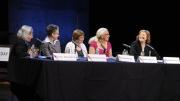Do laws drive social change, or, conversely, should laws merely respond to social change? Alumnae from the fields of journalism, academia, and, naturally, law took up this question at this year’s Radcliffe Day panel discussion, titled “From Front Lines to High Courts: The Law and Social Change.”
Indeed, the panel owed its very existence to a law: Title IX, passed in 1972, forbade the exclusion of women from education programs and activities receiving federal funds, Harvard Law School dean and panel moderator Martha Minow noted.
In setting up the discussion, Minow noted a paradox: “On the one hand, law is a tool for social change,” codifying equality and rights for disadvantaged groups when society has not yet reached true equality. On the other hand, “law is the tool of the status quo,” offering justifications for why things shouldn’t change.
Kathleen M. Sullivan, J.D. ’81, a constitutional law scholar and the former dean of Stanford Law School, said lawyers need activists and vice versa. Lawyers’ arguments are limited in many ways—for instance, by the facts of a case or the rules and conventions of the court. If law is to be an instrument of social change, it relies on activists operating outside that system. Social activists, meanwhile, “wouldn’t be as effective without the language that is spoken in court,” where the lawyers arguing a case may provide a legal rationale for the activists’ moral arguments, Sullivan said.
An audience member asked whether young lawyers could realistically expect their work to contribute to social change, given the hefty loans they must repay in the early years of their careers. “Yes, absolutely,” Sullivan responded without missing a beat. Social change does not only come through nonprofit law, she said; freedom of information depends on intellectual property law, and laws about importing goods from overseas affect the economy, American industry, and international relations.
Much of the discussion focused on gay rights and same-sex marriage. Speaking about seminal cases having to do with these issues, Sullivan noted the cultural change that occurred between 1986—when Bowers v. Hardwick upheld a Georgia law on the grounds that engaging in “homosexual sodomy” was not a constitutional right—and 2003, when the court overturned Bowers in Lawrence v. Texas on the basis of the right to privacy in the due process clause of the Fourteenth Amendment, ruling that states may not prohibit mutually consensual sexual relations between adults in their homes. That same year, in Massachusetts, Goodridge v. Department of Public Health upheld the right of same-sex couples to marry, paving the way for the first same-sex weddings in 2004.
In the Goodridge decision, 2012 Radcliffe Medalist Margaret Marshall, at the time the chief justice of the state’s Supreme Judicial Court, wrote that the Massachusetts Constitution “affirms the dignity and equality of all individuals” and “forbids the creation of second-class citizens,” and that the right to marry is “a fundamental right that is protected against unwarranted State interference.”
What changed between 1986 and 2003? Sullivan asked. She recalled a friend explaining to her that it was Will & Grace. She understood her friend to mean “the will of lawyers and the grace of judges”; no, her friend explained, she was referring to the cultural impact of the TV sit-com featuring Eric McCormack and Debra Messing as the title characters, a gay lawyer and his interior-designer best friend. (The show began airing in 1998.) “I just don’t watch much television,” Sullivan confided.
Noting that the majority of the U.S. population now supports same-sex marriage, panelist Linda Greenhouse ’68, the former longtime Supreme Court reporter for The New York Times (and now a Harvard Overseer), said, “I wouldn’t give up on this court in terms of the gay-rights question,” in response to an audience question about whether the current Supreme Court would be a hospitable forum for arguing a case on the issue.
Panelist Jennifer Gordon ’87, J.D. ’92, a Fordham University law professor who focuses on immigration and labor law, said court decisions tell us where we are as a society, and offered words of encouragement to those who support same-sex marriage, paraphrasing the Reverend Martin Luther King Jr.: “The arc of the universe is long but it bends toward justice.”
Suffolk University law professor Renee Landers ’77, who specializes in constitutional law and health law, noted that many things in her life would not have been possible without Brown v. Board of Education: both her parents’ marriage and her own would have been impossible under miscegenation laws that prohibited interracial marriage.
But racism persists, and other, later decisions (some by lower courts) undermined Brown, Landers said—for instance, ending school desegregation orders too soon, neglecting to recognize how slowly prejudice fades, and declining to support government policies that give extra support to schools in poorer districts.
Laws change because of “cognitive dissonance”—a mismatch between people’s life experiences and what laws encode—said Gordon, whose work includes advocating for undocumented immigrants’ rights. States started to legalize gay marriage after same-sex couples became more socially acceptable. But, she warned, change won’t necessarily come as swiftly for racial and ethnic minorities, immigrants, and the poor—groups that, unlike gays and lesbians, tend to be segregated in specific neighborhoods. Those who hold power in society may not interact daily with poor people, immigrants, and minorities, she pointed out.
When a disadvantaged group has equal status under the law and yet equality, in practice, does not result, Gordon said, the question becomes: “How do the ‘not us’ make social change?” She left listeners with a question: “What use is the law to them?”









